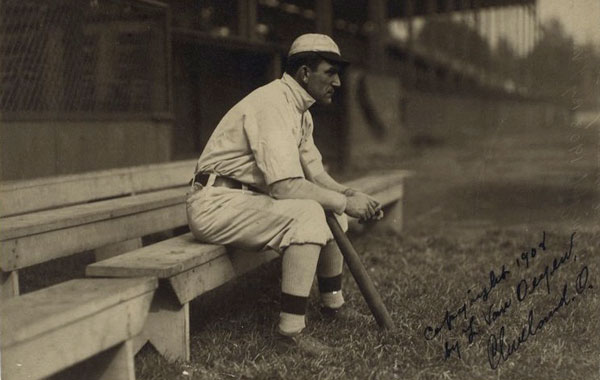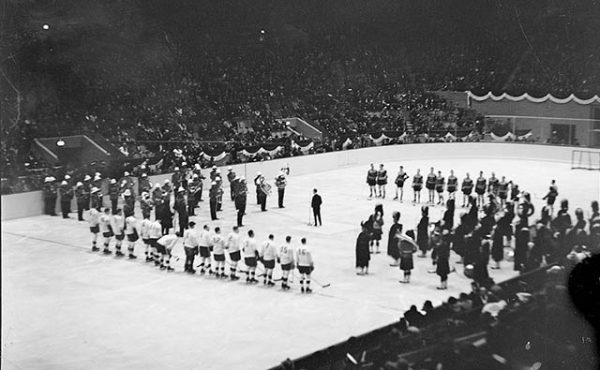When you ask Google who the greatest second baseman of all-time was, a few names pop up. Rogers Hornsby is a popular pick, a star for the St. Louis Cardinals back in the 1920s and ’30s. Some people say it was the Dodgers’ Jackie Robinson or the Reds’ Joe Morgan or the great Eddie Collins who played for the A’s and White Sox. Roberto Alomar’s name comes up, too — the Blue Jays Hall of Famer is easily one of the best ever. But he’s not the greatest second baseman to ever wear a Toronto uniform. That honour goes to the man who played second base for the Toronto Maple Leafs in 1917.
His name was Napoleon Lajoie and he was very, VERY good. No one in the history of the American League has ever had a higher batting average than he did in 1901 — he hit .426 for Philadelphia that season. He led the league in home runs and RBIs, too; one of the few players to ever win the batting “Triple Crown”. That year, he stuck out only nine times, which is just plain silly. And it wasn’t a fluke. By the end of his career, he’d become one of the first players in baseball history to collect 3,000 hits.
Modern stats love him, too. By Wins Above Replacement (which tries to judge a player’s total value), Lajoie is ranked as the third most valuable second baseman in the history of the game — the 19th greatest player of all-time. Better than Joe DiMaggio or Pete Rose or Mark McGwire. He was one of the first players inducted into the Baseball Hall of Fame.
“Lajoie was one of the most rugged players I ever faced,” Cy Young once said. “He’d take your leg off with a line drive, turn the third baseman around like a swinging door and powder the hand of the left fielder.” Sports writers said he was so effortlessly graceful that he made even chewing tobacco look good. He was so dedicated to the craft of hitting that he never went to the movies or read a newspaper on a train for fear of hurting his eyes. As a player-manager in Cleveland, Lajoie was so popular they literally named the team after him: they became the Cleveland Napoleons. Naps for short.
Even as a grizzled veteran at the age of 38, Lajoie was still great: he was worth 5 Wins Above Replacement that year (better than anyone on the 2013 Blue Jays). But after that, his skills began to seriously decline. For a while, he kept playing anyway, chasing the dream of his first championship — one had slipped away when he was cut by an opposing player’s spikes, got blood poisoning and nearly lost his foot; another in a heartbreaking loss on the final day of the season. But at the age of 42, after 21 years in the Major Leagues, age had finally caught up with him. Lajoie called it quits having never won a pennant.
That’s when he came to Toronto. He might not have been good enough to play second base in the Majors anymore, but he had a lot of knowledge to pass down to younger players. And so, he signed on as the manager for one of the most storied franchises in the history of the Minor Leagues: The Toronto Maple Leafs.
By then, our city already had a long history of success on the baseball field. Toronto’s first championship came all the way back in the 1880s, at beautiful Sunlight Park overlooking the eastern slope of the Don Valley (just south of Queen). The Maple Leafs were founded soon after that, in the 1890s; before long, they’d moved to a new spot on the Islands. When an early, wooden version of the stadium burned down, they got a gorgeous new ballpark. Hanlan’s Point Stadium was hailed as the biggest in the Minor Leagues when it first opened in 1910: it boasted more than 17,000 seats. Over the next few years, it witnessed two more championships and the very first professional home run by a young pitcher named Babe Ruth. His blast soared over the fence into the lake.
Now, Hanlan’s Point would be home to Lajoie. And it wasn’t his first connection to Canada: his parents were both Québecois; his older siblings had been born there, growing up on a farm outside Montreal. Lajoie signed on as the Leafs manager, responsible for signing and trading players, as well as decisions on the field. He also said he’d play “a little” second base. But that’s not the way things turned out.
The old second baseman had slowed down considerably, but he still had something left in the tank. Against the younger, less experienced, less talented minor leaguers, Lajoie thrived. He hit clean up for the Leafs that year, and did a hell of job of it. He led the league with a .380 average, racked up a league-leading 221 hits and 39 doubles. At one point, he put together a 21-game hitting streak. And he did it all in the face of adversity: his fear of water made the ferry to the Islands an ordeal; the freezing temperatures of an usually cold Canadian spring meant games were being cancelled as late as Victoria Day that year; and with the First World War raging overseas, some players were being drafted halfway through the season. Others rebelled against Lajoie’s leadership; one pitcher just up and left the team. Lajoie got suspended twice for arguing with umpires. But he was still so popular that everywhere the Maple Leafs went, opposing teams held “Lajoie Days” and showered him with gifts. He was playing so well in Toronto that Major League teams started showing an interest again. That summer, both the Washington Senators and the Chicago Cubs offered him a chance to come back to the Majors, but he turned them both down. He wanted to finish what he’d started in Toronto.
After a slow start to the season, the Maple Leafs were right in the thick of the pennant race by the end of August — battling it out with Baltimore, Providence and Newark over the last two weeks of the season. Lajoie led the way as the manager and as the team’s star player. He went 6 for 8 in one double-header against Buffalo, belted two home runs in an extra innings win against Montreal, and then went 6 for 8 again in another double-header on the last weekend of the season. “Lajoie was himself worth four ordinary players,” the Globe gushed. With two games left to play on the very final day, the Toronto Maple Leafs were in the driver’s seat: if they won both games, they’d finish in first place.
In the opening game, it was their ace — Harry Thompson — who carried the team. He shut out the Rochester Hustlers over the course of nine innings, only giving up three hits on the way to his 25th victory of the season. The Maple Leafs won 1-0.
The second game started off as a tense, scoreless battle over the first five innings. Then Lajoie — who was playing first base that day — doubled two men home. It proved to be all they needed. Toronto went on to win 5-1. It was all over. And at first base, Lajoie was the last to touch the ball.
“A broad grin overspread Lajoie’s features as he took the throw from Murray to record the 27th out,” the Globe reported. And that grin came with good reason. After more than 20 years in baseball, he’d finally done it. Napoleon Lajoie had won a pennant.
Photo: Napoleon Lajoie is 1908 (via Wikipedia)
A version of this post originally appeared on the The Toronto Dreams Project Historical Ephemera Blog. You can find more photos, sources, links and other related stories there.




One comment
Great article . Very few people even know Toronto had a ball club back then. With so many great players like Nap Lajoie, Joe Kelly,George Gibson and many others . As well as one of the best teams of all time The 1918 Toronto Maple Leafs. Look in to the T206 tobacco card set from 1909-1911 for all these greats. Some really incredible stories,blew me away.